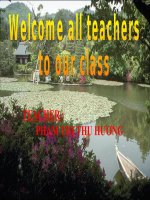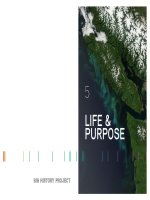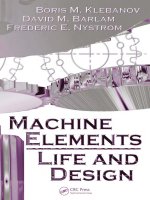Life and purpose
Bạn đang xem bản rút gọn của tài liệu. Xem và tải ngay bản đầy đủ của tài liệu tại đây (1.23 MB, 8 trang )
LIFE &
PURPOSE
5
By Ursula Goodenough
A BIOLOGIST’S REFLECTION
ON THE QUALITIES THAT
DEFINE LIFE
LIFE &
PURPOSE
2 3
What’s the difference
between nonlife and life?
To answer this question,
we first need to define
life. I’ll lay out what are
to me the key hallmarks
of life, and then offer a
response that flows from
such an understanding.
4 5
Every organism is a self
A key concept is that every organism is a self, a being. To be a “self” is to
engage in two fundamental activities: self-generation and self-maintenance.
Self-generation
Self-generation entails the making of a self. If you’re a single-celled organ-
ism like a yeast, this involves starting out small, growing large, and dividing
into two small daughter-yeasts that start the process again. If you’re a multi-
celled organism like a human, this involves starting out as a single fertilized
egg, developing from an embryo to a fetus, and then taking the path from
newborn to old age.
In all organisms on our planet today, the key players in self-generation
are proteins. When a particular protein is made, it folds up into a particular
shape, with crevices and bumps — something like a jigsaw-puzzle piece in
three dimensions. These shapes allow proteins to do two major activities.
The first is to interact with other proteins, with the bumps fitting precisely
into the crevices, to form the thousands of different kinds of chemical struc-
tures that make up a cell. Most parts of a cell are constructed from proteins,
including the filaments that act as cellular skeletons, the channels that let
ions in and out of the cells, and the receptors that let the self know what’s
going on in the environment.
The second activity of proteins is to serve as enzymes, which allow chemi-
cal reactions inside the cell to take place with remarkable efficiency and
accuracy. Again, shape is the key. The bumps and crevices bring together
the participants in a chemical reaction and ensure that they form the proper
kinds of chemical bonds with one another.
Self-maintenance
Critical to self-generation is obtaining the molecules and the energy that the
self needs to run the store. One strategy is to use photosynthesis, turning
the Sun’s light energy into food. The second is to ingest molecules that are
made as a consequence of photosynthesis — that is, to eat — and then break
6 7
them down, using the energy released to drive self-generation. Here again,
the shapes of enzymes are critical, but instead of controlling the formation
of chemical bonds as in self-generation, they deftly supervise the breaking
of chemical bonds, coupling this activity with the formation of energy-
rich molecules like ATP (adenosine triphosphate) that keep the cell going.
Self-maintenance also entails self-protection, avoiding environmental
hazards, predators, and disease.
Every organism is instructed
All the proteins we’ve been thinking about are encoded in genes embedded
in DNA molecules. Each gene specifies the amino-acid sequence of a par-
ticular protein, and that sequence then defines how the protein will fold up
into its functional shape.
The full set of genes necessary to pull together a self-generating and self-
maintaining self is called a “genome.” A yeast genome and a human genome
have many genes in common, notably those concerned with the universal
project of self-maintenance, and many others that are distinctive. Daughter
organisms inherit copies of genomes from parent organisms, allowing that
kind of organism to continue and spread.
Embedded in the organization of genomes is the capacity to express certain
genes, and hence certain proteins, on some occasions and not others.
When it’s time to copy DNA into daughter molecules, the genes encoding the
DNA-copying enzymes are “switched on”; when the copying process is
completed, these genes are “switched off.” When it’s time for you to make
red blood cells, genes encoding the hemoglobin protein are switched on
in certain bone-marrow cells but remain switched off in most of the cells in
your body. Thus a genome isn’t just a collection of genes; it functions con-
tinuously to instruct self-generation and self-maintenance.
8 9
Every organism can evolve
Although DNA is copied with remarkable accuracy, mistakes sometimes
happen, giving rise to mutant genes that encode variant amino-acid sequences
and hence give rise to proteins with variant shapes. Also occurring are
“mutations” that change the timing or magnitude of protein production.
The mutation may have no effect, at least in the short term, in which case
the mutant daughter may self-organize and self-maintain just like the
parent. At the other extreme, it may have disastrous consequences on self-
organization and self-maintenance, and the daughter will not survive.
The most interesting mutations are those that generate instructions for a
viable daughter that is somewhat different from its parent. For example,
a parent duck may have delicate foot webbing while the webbing of a mutant
daughter may be extra-thick. What happens next is totally dependent on
environmental context. If the ducks hang out on mudflats, the mutant feet
may allow for surer footing, hence better opportunities for feeding and fleeing
predators, and the thick-footed trait will likely spread into future generations;
if the ducks live in grasslands, the mutant feet may slow things down and
the trait will be less likely to spread.
What I’ve just described is Darwinian evolution: inherited variations, coupled
with natural selection. The ability of living organisms to evolve has generated
the spectacular biodiversity that surrounds us, and without it, we humans
would never have shown up.
Ernst Haeckel’s 1879 illustration of the “tree of life” shows humans as the pinnacle of
evolution, a common view among early evolutionists
10 11
Every organism has purpose
So, with this sense of what life is, can we come up with a single character-
istic that distinguishes life from nonlife? Is there one towering difference
between a mountain and a whale? After all, both are made of molecules.
Both engage in chemistry. Both change through time.
For me, the most interesting single generalization is that organisms are
purposive whereas nonlife is not. Organisms are about something, for
something: muscles are for movement; eyes are for seeing. Organisms have
goals. The short-term goal is to self-generate and self-maintain in a given
environmental context. The long-term goal is to pass genome copies on to
offspring, a goal that succeeds only if self-generation and self-maintenance
succeed. Mountains are splendid, to be sure, but in the end they aren’t goal
directed. They just are.
Taking this perspective, one could say that when life showed up on Earth,
something completely new showed up: the emergence of purpose. Whether
life, and hence purpose, exists anywhere else in the Universe is unknown
and may remain a mystery. Meanwhile, we can enjoy and revel in the aston-
ishing purposiveness that surrounds us here on Earth.
Comparing words
Ursula Goodenough and David Christian describe the qualities that define
life in slightly different ways. Scholars don’t always use the same words.
This guide makes some connections:
David Christian Ursula Goodenough
Metabolism Self-generation
Homeostasis Self-maintenance
Reproduction Instructed and purposive
Adaptation Evolvability
12
Ursula Goodenough
Ursula Goodenough is a professor of biology and a research leader at
Washington University in St. Louis, Missouri. She has devoted years of
research to the flagellated green soil alga called Chlamydomonas reinhardtii.
Goodenough has also written or coauthored numerous books, including
The Sacred Depths of Nature (1998). Goodenough recently initiated research
work on biogenesis in Chlamydomonas, contributing to an international
effort to produce algal biodiesel as an alternative energy source.
Image credits
Phytoplankton off Vancouver Island,
courtesy of Jeff Schmaltz, MODIS Land Rapid Response Team
at NASA GSFC
Japanese macaques in Jigokudani Onsen, Nagano, Japan
© Radius Images/CORBIS
A sperm whale
© Denis Scott/CORBIS
The Matterhorn, one of the highest peaks in the Alps
© Dirk Beyer









